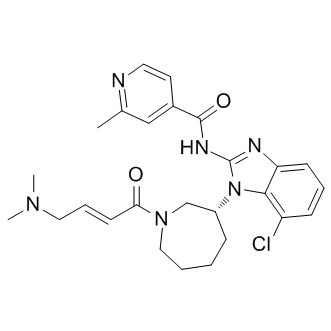| Description: |
Nazartinib (EGF816) is a novel, covalent mutant-selective EGFR inhibitor, with Ki and Kinact of 31 nM and 0.222 min−1 on EGFR(L858R/790M) mutant, respectively. |
| Target: |
EGFRL858R/T790M:31 nM (Ki) |
| In Vivo: |
In H1975 mouse xenograft model, Nazartinib (EGF816; 50 and 20 mg/kg or 25 mg/kg, p.o.) demonstrates dose-dependent efficacy with near complete tumor cells regression at the highest dose tested (50 mg/kg)[1]. In H1975 mouse model, Nazartinib (EGF816; 10 mg/kg, p.o.) induces tumor growth inhibition with a T/C (tumor/control volume) of 29%, and when doses are 30 and 100 mg/kg, tumor regressions are achieved (T/C, -61% and -80%, respectively). In the H3255 xenograft model, Nazartinib (30 mg/kg, p.o.) shows significant antitumor activity. Antiproliferative activity of Nazartinib on 89 lung cancer cell lines indicates that Nazartinib selectively inhibits cell lines containing EGFR with catalytic domain mutations[2]. |
| In Vitro: |
Nazartinib (EGF816) has inhibitory effect on the mutant cell lines with IC50s of 4, 6, 2 nM in H1975, H3255, and HCC827, respectively, and demonstrates improved ADME and PK properties[1]. Nazartinib (EGF816) shows potent inhibition of pEGFR levels in H3255, HCC827, and H1975 cell lines with EC50 values of 5, 1, and 3 nM, respectively. Nazartinib inhibits cell proliferation, with EC50 values of 9, 11, and 25 nM in H3255, HCC827, and H1975, respectively. Nazartinib has an OC50 (compound concentration at 50% occupancy) value of 2 and 5 nM on HCC827 and H1975, respectively[2]. |
| Kinase Assay: |
Recombinant kinase domain of EGFR L858R and T790M-L858R mutants are incubated with Nazartinib to confirm covalent modification of EGFR and site of adduction. Recombinant enzyme is incubated at room temperature with a 20-fold molar excess of compound in 40 mM Tris, pH 8, 500 mM NaCl, 1% glycerol, 5 mM TCEP for 1 h. The reaction is quenched by addition of dithiothreitol (DTT, 80-fold excess to compound) and transfer to ice. A third of the reaction (10 μL) is processed for intact MS by adding an equal volume of 6 M Guan HCl, 100 mM Tris, pH 8, 20 mM DTT, 10 mM TCEP and incubating at room temperature for 15 min. Intact MS analysis is performed on an Agilent 6520 QToF mass spectrometer equipped with a dual spray ion source (IS of 4500 V, fragmentor of 250 V, fas temp of 350°C, and skimmer of 75 V). The samples are injected onto a PLRP-S column (2.1 mm×50 mm), heated to 60°C, and desalted for 2 min at 500 μL/min and 3% B prior to elution with a fast gradient of 3-50% B in 3 min (B, 0.1% formic acid). The data are analyzed in MassHunter for automatic peak selection, integration, and spectral deconvolution with a mass range of 15 000-75 000 Da. |
| Cell Assay: |
Cells are seeded 500 cells/well in solid white 384-well plates in maintenance media. Serial diluted compounds are transferred to cells. After 3 days, cell viability is measured by CellTiter-Glo. BaF3 cell viability is measured 2 days after compound treatment using Bright-Glo Luciferase Assay System. Luminescent readout is normalized to 0.1% DMSO-treated cells and empty wells. Five EGFR TKI-resistant cell lines are generated at Massachusetts General Hospital. MGH134, MGH121, MGH141, and MGH157 are derived from patients who developed resistance to erlotinib with acquired T790M mutation. MGH119-R is generated in vitro by treating MGH119 with gefitinib for a prolonged period. The sensitivity of Nazartinib on these lines is tested. |
| Animal Administration: |
Foxn1 nude mice bearing the H1975 tumors are randomized and used for efficacy studies. Compounds are formulated in 0.5% MC, 0.5% Tween 80 suspension formulation and administered by oral gavage at a dosing volume of 10 μL/g of the animal body weight. Animals in each group receive one oral dose of either vehicle (n=6) or the different test compounds (n=6 in each dose group). Plasma samples are collected for PK measurements at 30 min, 3 h, 7 h, and 24 h after last dose on day 5. Body weight is monitored daily, and the % change in body weight is calculated as [(BWcurrent-BWinitial)/(BWinitial)]×100. Data are presented as percent body weight change from the day of treatment initiation. Tumor sizes are assessed three times during the efficacy study for 5 days. Tumor sizes are determined by using caliper measurements. Tumor volumes are calculated with the formula (length×width×width)/2. |
| References: |
[1]. Lelais G, et al. Discovery of (R,E)-N-(7-Chloro-1-(1-[4-(dimethylamino)but-2-enoyl]azepan-3-yl)-1H-benzo[d]imidazol-2-yl)-2-methylisonicotinamide (EGF816), a Novel, Potent, and WT Sparing Covalent Inhibitor of Oncogenic (L858R, ex19del) and Resistant (T79
[2]. Jia Y, et al. EGF816 Exerts Anticancer Effects in Non-Small Cell Lung Cancer by Irreversibly and Selectively Targeting Primary and Acquired Activating Mutations in the EGF Receptor. Cancer Res. 2016 Mar 15;76(6):1591-602 |






















